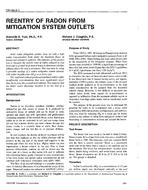Numerous fault detection and diagnostic system techniques have been developed for HVAC systems, but most focus on detecting faults at the component level, for example, airhandling units or variable air volume boxes. This paper examines the use of the ASHRAE simplified energy analysis procedure (SEAP) for fault detection at the whole-building level. In the procedure examined, an implementation of the SEAP is “calibrated†to a period of measured heating and cooling data from a building so the simulated data closely follow the measured data. A small adjustment is added to the simulated data so the total adjusted simulated heating and cooling consumption values exactly match the measured heating and cooling consumption totals for the same period. The adjusted version of the calibrated SEAP simulation is then used to predict future consumption, using future weather data. Visual comparison with future measured data is used to diagnose significant deviations from expected performance. The procedure is applied retrospectively to three years of measured consumption data as a test. It clearly identifies three significant operational changes that occurred during the test period. Three different presentation formats are tested for fault identification—monthly deviations, daily percent deviations, and cumulative deviation plots. All have value, and it is ultimately a user preference as to which is the most informative.
Units: SI
Citation: ASHRAE Transactions, vol. 113, pt. 2
Product Details
- Published:
- 2007
- Number of Pages:
- 10
- File Size:
- 1 file , 1.4 MB
- Product Code(s):
- D-LB-07-005


